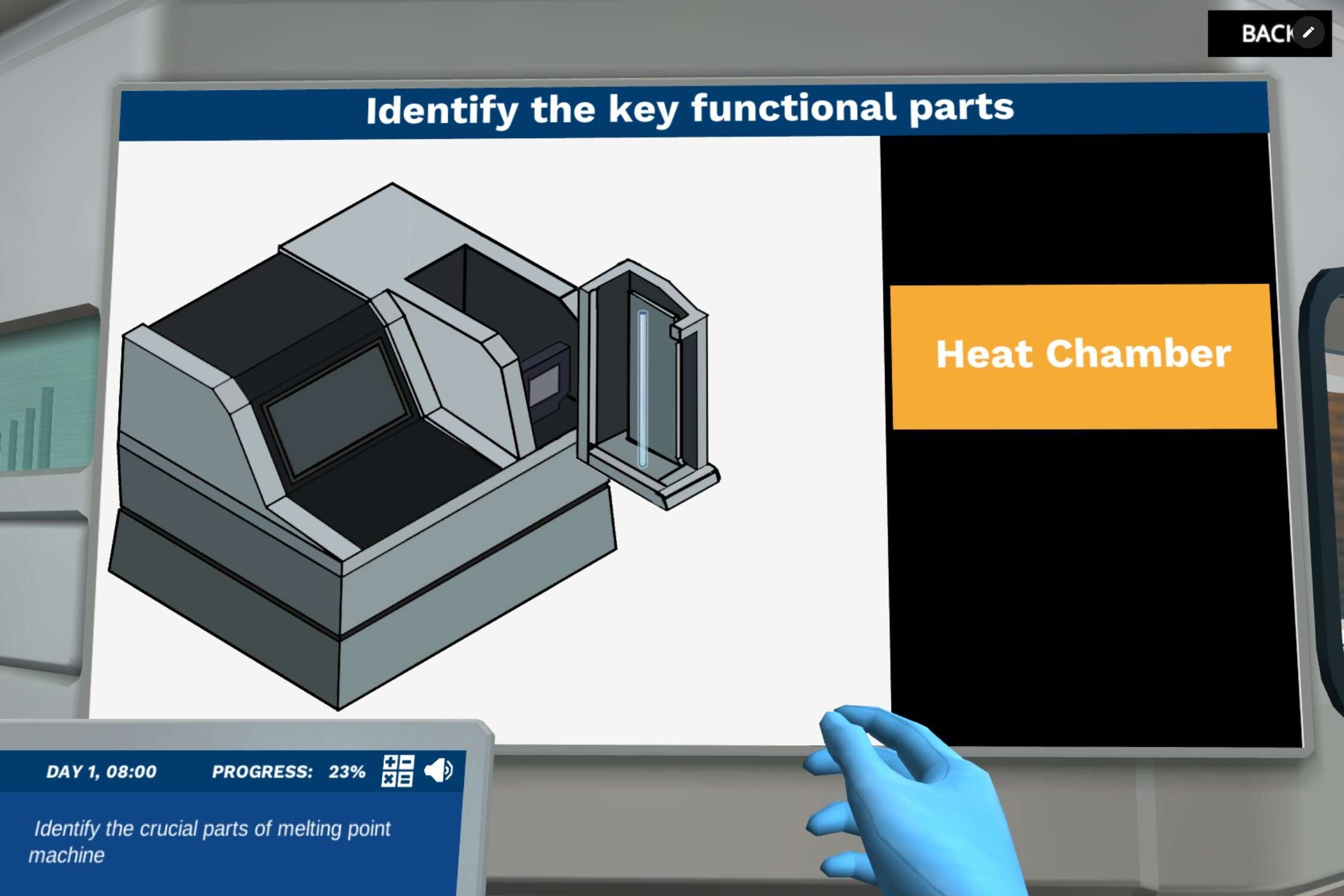Heading 1
Heading 2
Heading 3
Heading 4
Heading 5
Heading 6
Lorem ipsum dolor sit amet, consectetur adipiscing elit, sed do eiusmod tempor incididunt ut labore et dolore magna aliqua. Ut enim ad minim veniam, quis nostrud exercitation ullamco laboris nisi ut aliquip ex ea commodo consequat. Duis aute irure dolor in reprehenderit in voluptate velit esse cillum dolore eu fugiat nulla pariatur.
Block quote
Ordered list
- Item 1
- Item 2
- Item 3
Unordered list
- Item A
- Item B
- Item C
Bold text
Emphasis
Superscript
Subscript
About This Simulation
Learn the techniques and application of melting point analysis and substance purity graphs. Explore the application of the technique in organic syntheses when determining the purity of a solid organic compound.
Learning Objectives
- Prepare a sample for melting point analysis
- Detail the principles of using the melting point as an indicator of substance purity
- Understand melting point equipment mechanics and basic principles of usage
About This Simulation
Lab Techniques
- Melting point
- Melting point determination
Related Standards
- Early Stage Bachelors Level
- EHEA First Cycle
- Support for laboratory skills at all levels
- US College Year 1
- US College Year 2
- US College Year 3
- Chemistry Unit 9
- Chemistry 5
Learn More About This Simulation
About this simulation
Melting organic solids: it’s the same principle as when ice melts! In this simulation, you will be introduced to the melting point analysis technique and apply it to organic syntheses you would carry out in the lab. Uncover one of the simplest and most informative techniques for indicating substance purity and learn how to determine whether you synthesized a pure substance using the recorded data and graphs.
Sample preparation
Get first-hand virtual lab experience preparing a sample for melting point analysis. Start by learning the correct protocol for sample loading, including how to choose the right tube for the machine and amount of sample required. Tips and tricks like these will help ensure maximum accuracy and precision for the sample measurement.
Test your creativity!
One of the great things about being in a virtual lab is that you can break apart the machine. Uncover the key components behind a functioning melting point machine to understand the conditions required to melt your sample. You’ll even get the chance to build your own functional melting point machine from common laboratory equipment!
Analyze substance purity graphs
Get a deeper look at what is happening with your sample inside the machine using our high tech hologram! Observe the different stages of melting: Moistening Point, Sintering Point, Meniscus Point and Clear Point. Learn about the states of matter when the solid sample reaches each of these stages and relate them to the plotted points on a substance purity graph, also known as the heat curve for a solid compound.
For Science Programs Providing a Learning Advantage
Boost STEM Pass Rates
Boost Learning with Fun
75% of students show high engagement and improved grades with Labster
Discover Simulations That Match Your Syllabus
Easily bolster your learning objectives with relevant, interactive content
Place Students in the Shoes of Real Scientists
Practice a lab procedure or visualize theory through narrative-driven scenarios


FAQs
Find answers to frequently asked questions.
Heading 1
Heading 2
Heading 3
Heading 4
Heading 5
Heading 6
Lorem ipsum dolor sit amet, consectetur adipiscing elit, sed do eiusmod tempor incididunt ut labore et dolore magna aliqua. Ut enim ad minim veniam, quis nostrud exercitation ullamco laboris nisi ut aliquip ex ea commodo consequat. Duis aute irure dolor in reprehenderit in voluptate velit esse cillum dolore eu fugiat nulla pariatur.
Block quote
Ordered list
- Item 1
- Item 2
- Item 3
Unordered list
- Item A
- Item B
- Item C
Bold text
Emphasis
Superscript
Subscript
A Labster virtual lab is an interactive, multimedia assignment that students access right from their computers. Many Labster virtual labs prepare students for success in college by introducing foundational knowledge using multimedia visualizations that make it easier to understand complex concepts. Other Labster virtual labs prepare learners for careers in STEM labs by giving them realistic practice on lab techniques and procedures.
Labster’s virtual lab simulations are created by scientists and designed to maximize engagement and interactivity. Unlike watching a video or reading a textbook, Labster virtual labs are interactive. To make progress, students must think critically and solve a real-world problem. We believe that learning by doing makes STEM stick.
Yes, Labster is compatible with all major LMS (Learning Management Systems) including Blackboard, Canvas, D2L, Moodle, and many others. Students can access Labster like any other assignment. If your institution does not choose an LMS integration, students will log into Labster’s Course Manager once they have an account created. Your institution will decide which is the best access method.
Labster is available for purchase by instructors, faculty, and administrators at education institutions. Purchasing our starter package, Labster Explorer, can be done using a credit card if you are located in the USA, Canada, or Mexico. If you are outside of North America or are choosing a higher plan, please speak with a Labster sales representative. Compare plans.
Labster supports a wide range of STEM courses at the high school, college, and university level across fields in biology, chemistry, physics, and health sciences. You can identify topics for your courses by searching our Content Catalog.















